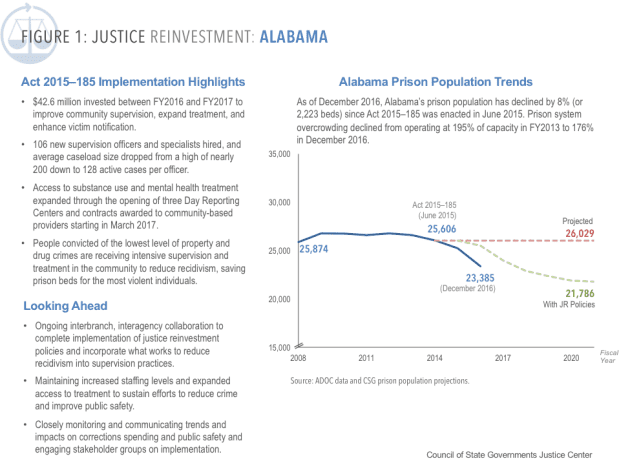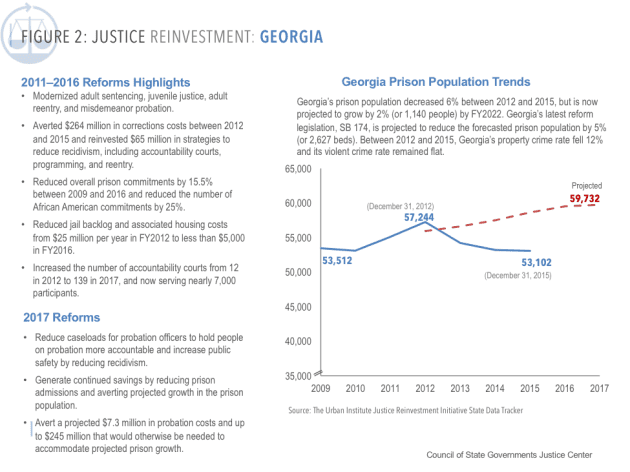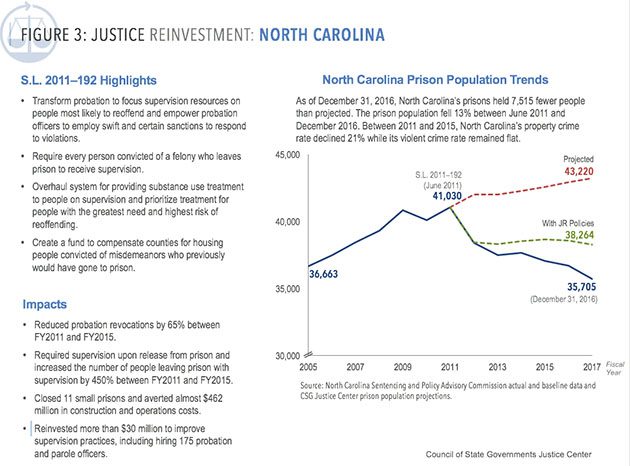
Capitol Hill Briefing Highlights Three States’ Reductions in Prison Costs and Reinvestments in Public Safety
On March 8, state leaders from Alabama, Georgia, and North Carolina convened at the Russell Senate Office Building in Washington D.C. to discuss how these states have used the Justice Reinvestment Initiative (JRI)—an approach designed to reduce spending on corrections and reinvest in more effective strategies to reduce recidivism and bolster public safety. Since 2010, 30 states have participated in JRI.
In 2015, Alabama passed justice reinvestment legislation to tackle prison overcrowding, high supervision caseloads and a dearth of treatment in the community. Since that time, the state’s prison population has decreased by 8 percent. [See Figure 1, click to enlarge]
For the past six years, Georgia has used justice reinvestment to avert prison growth, expand accountability courts, improve reentry and strengthen the probation system. The state saw a 6 percent reduction in its prison population between 2012 and 2015 and is preparing to pass additional legislation which is projected to reduce the prison population further. [See Figure 2, click to enlarge]
North Carolina adopted justice reinvestment policies in 2011 and has since seen probation recidivism drop by nearly half. In addition, the state has closed 11 small prison facilities and averted almost $462 million in construction and operations costs, allowing a reinvestment of more than $30 million to improve supervision practices. [See Figure 3, click to enlarge]
This project was supported by Grant No. 2013-ZB-BX-K002 awarded by the Bureau of Justice Assistance. The Bureau of Justice Assistance is a component of the Department of Justice’s Office of Justice Programs, which also includes the Bureau of Justice Statistics, the National Institute of Justice, the Office of Juvenile Justice and Delinquency Prevention, the Office for Victims of Crime, and the SMART Office. Points of view or opinions in this document are those of the author and do not necessarily represent the official position or policies of the U.S. Department of Justice.
 Vermont Executive Working Group Hears Recommendations on How to Improve Domestic Violence Responses
Read More
Vermont Executive Working Group Hears Recommendations on How to Improve Domestic Violence Responses
Read More
 New Hampshire Governor’s Commission Reviews Justice Reinvestment Initiative Data Analysis and Proposed Policy Recommendations
New Hampshire Governor’s Commission Reviews Justice Reinvestment Initiative Data Analysis and Proposed Policy Recommendations
On April 6, 2023, the New Hampshire Governor’s Advisory Commission on Mental…
Read More Explainer: Minnesota’s Justice Reinvestment Legislation Results in $43.6 Million Annual Increase in Community Supervision System
Read More
Explainer: Minnesota’s Justice Reinvestment Legislation Results in $43.6 Million Annual Increase in Community Supervision System
Read More
 Biden Signs Six-Bill Spending Package Funding Key Criminal Justice Programs
Biden Signs Six-Bill Spending Package Funding Key Criminal Justice Programs
On March 9, 2024, President Joe Biden signed a $460 billion spending…
Read More














